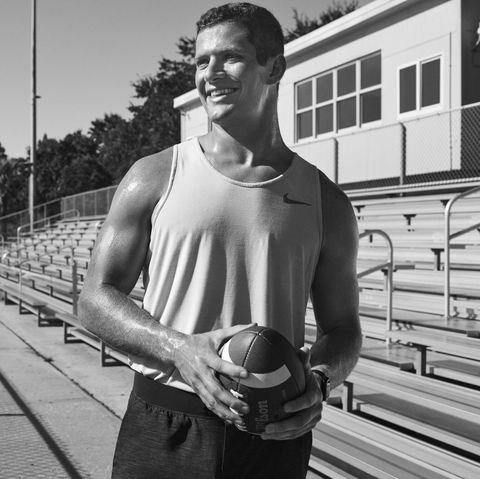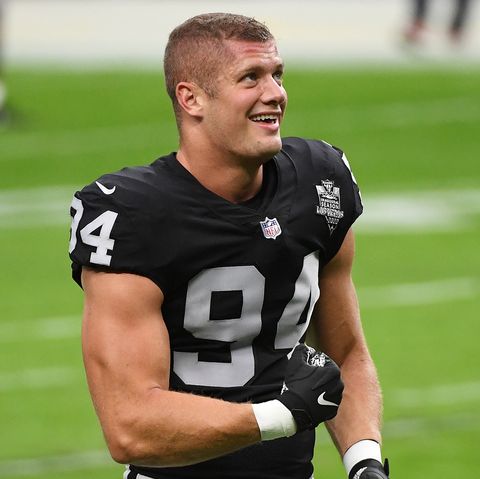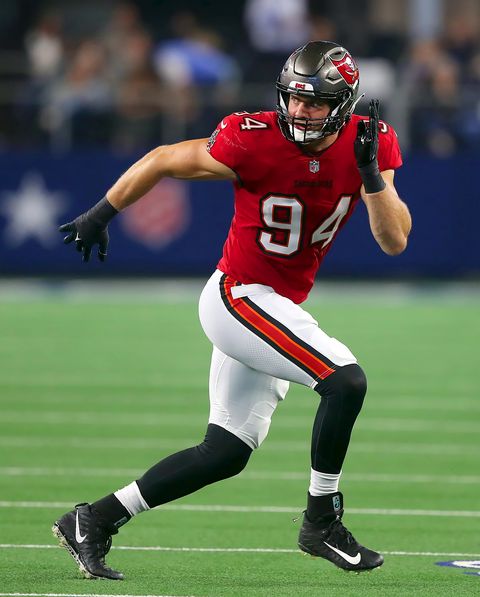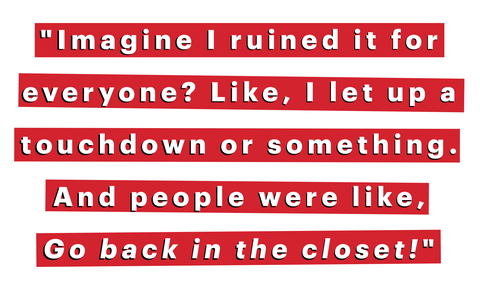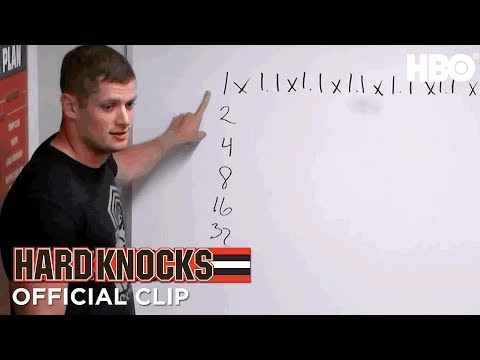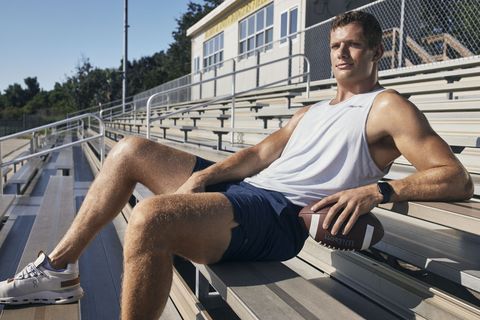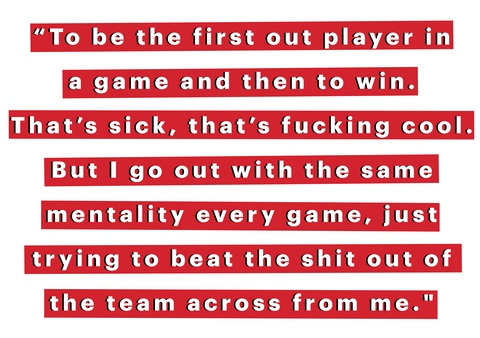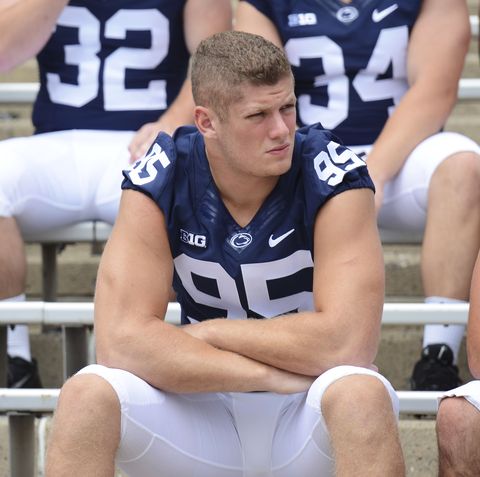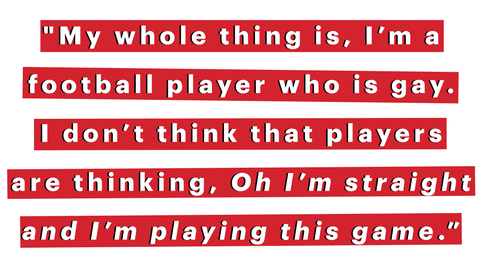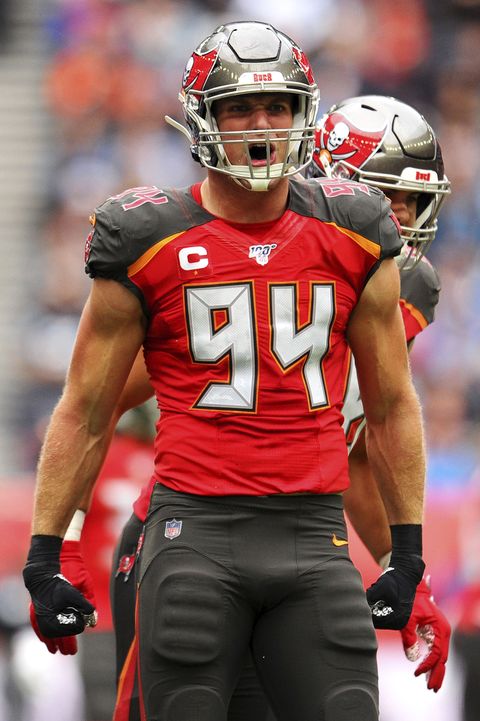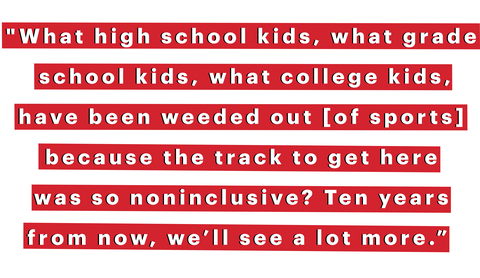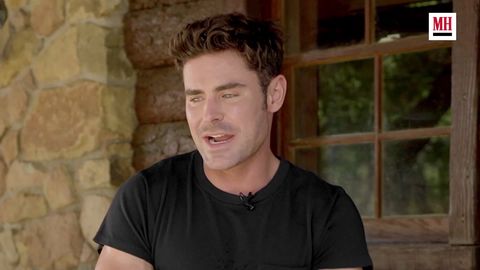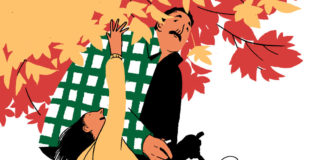SEVERAL WEEKS AFTER CARL NASSIB came out in June 2021—becoming the first openly gay active player in NFL history—he completed a strip sack leading the Las Vegas Raiders to a week-one win over the Baltimore Ravens. It was a thrilling play and an impressive show of athleticism from the defensive lineman. It was also, in its own way, a statement. For years, coaches, commentators, and league officials had wrung their hands, suggesting that an openly gay player in the locker room would divide the team and sow chaos; the fear was so pervasive it became known as the distraction myth. Yet in one swift play—with 15.3 million people watching at home, marking ESPN’s most viewed season opener in nearly a decade—Carl Nassib vanquished the ghost.
He showed that all the talk about who’s gay and what it may or may not do to the team was the actual distraction—Nassib was there to make some tackles and play some football, and he did them excellently. “Imagine I ruined it for everyone?” he says now. “Like, I let up a touchdown or something. And people were like, Go back in the closet! That could have been horrible.”
Nassib’s laughing—and it’s funny—but he also makes it clear that he hasn’t really thought much about that game since. He didn’t step out onto the field that day with the weight of the world on his broad shoulders. “I felt really lucky that I could be on a big stage and, like, make a good play while representing the community,” he says. “To be the first out player in a game and then to win. That’s sick, that’s fucking cool. But I go out with the same mentality every game, just trying to beat the shit out of the team across from me. My whole thing is, I’m a football player who is gay,” or, more clearly, who happens to be gay. “I don’t think that straight players are thinking, Oh, I’m straight and I’m playing this game.”
He’s right, of course. And he didn’t ask to be the first active openly gay player. He isn’t even sure others will follow soon, though there are certainly closeted gay players in the league. (More on that later.) Still, he wears it well. In his minute-long coming-out video, notable for its nonchalance—“I just want to take a quick moment to say that I’m gay”—Nassib swiftly pivoted the attention away from himself, announcing he was donating $100,000 to the Trevor Project, a nonprofit focused on suicide prevention and crisis intervention for LGBTQ youth. The NFL matched that sizable donation (not a given from a league that did Colin Kaepernick dirty), as did the travel website Booking.com. Daily donations to the Trevor Project also doubled that week, with traffic to its site up by more than 350 percent.
It wasn’t just that people were suddenly giving money. These were new donors, explains Kevin Wong, vice president of communications for the nonprofit. “The Venn diagram of people who might have been fans of the Raiders and know about the Trevor Project—maybe that sliver isn’t so big,” says Wong. “Carl changed some hearts and minds that day.”
It was a historic moment. And in the 24 hours following Nassib’s announcement—which garnered more than 766,000 likes and drew praise from President Biden—Nassib’s became the top-selling jersey. But then what? What if the person at the center of this seismic shift would rather talk about anything but?
NASSIB AND I meet via Zoom in late August. He’s just signed a one-year contract with the Tampa Bay Buccaneers and is still getting settled in. He spent the day car shopping, he tells me, deciding on (he thinks) a GMC Yukon. At six-foot-seven, he had limited options: “They have a new electric Hummer that I sat in, and I couldn’t even get in. Like my head kept hitting the fucking ceiling. So that sucked.”
He also had to buy kitchenware for the house he’s renting from a former NFL player (a man who presumably doesn’t cook). Nassib turns the camera around to show me the space, which looks like the kind of generic, well-appointed home you’d see on HGTV as you were falling asleep. “I’m not always a big fan of open concept,” the 29-year-old says, “but he did a good job with it.”
That Nassib would be playing football this season—in Tampa or anywhere, really—was never guaranteed. He was cut by the Raiders in March, a victim of the salary cap. (Nassib signed a three-year, $25 million deal in 2020 but was let go after two good-but-not-$25-million-good seasons.) The average NFL career also spans about three years; this would be Nassib’s seventh. Still, prognosticators assumed someone would pick him up. The NFL is a pass-happy league, and Nassib’s a productive pass rusher. Yet the months ticked by, with Deadspin publishing an article in June titled “Has anyone noticed Carl Nassib isn’t on an NFL roster?”
Fans speculated that Nassib’s sexuality (or the media attention around it) was to blame. It was a reasonable assumption, considering how the league treated Michael Sam. In 2014, Sam (a defensive end and star college player for Missouri) was picked by the Rams, becoming the first openly gay player drafted by an NFL team. Sam famously kissed his boyfriend live on ESPN that night, and he arguably paid the price. Sam would put up decent numbers in practice, but St. Louis cut him before the regular season and he wound up in the Canadian league. He now plays for the European League’s Barcelona Dragons. I had remembered this whole thing differently—had been certain Sam just wasn’t good enough—but Outsports crunched the numbers, and the only thing separating Sam from 25 other defensive ends signed to futures contracts that year was his sexuality.
Despite being cut, Nassib felt he had “a lot in the tank” and bet on himself, building a serious gym on the six-acre farm he’d bought in his hometown of West Chester, Pennsylvania. “I’m not a naturally built guy,” he says. “I have to constantly work out. I haven’t taken a vacation in ten years, because I can’t miss a week of working out. The NFL is the best athletes in the world with the best work ethic. I can’t take my foot off the gas.” He prefers being in control. And that routine extends to breakfast. “I have the same five eggs and quinoa every single morning with spinach and some sharp cheddar cheese.” By the way, he says those eggs are “fucking delicious. I had it this morning. Ten out of ten.”
There’d been talk in May that the Rams were interested, but nothing was confirmed. “I was pretty positive I was going to play this year,” Nassib says. But tick-tock. Not long before the Bucs called in August—offering him a one-year deal worth $1.035 million, plus a $152,500 signing bonus—Nassib nearly bought an apartment in Manhattan’s Gramercy Park. “I don’t want to say who I turned down,” he says. “I don’t want to be disrespectful. This is my seventh year. I’ve done really well. I’m just so lucky that I didn’t have to take the first opportunity that came knocking—because it was a shit opportunity.”
As with everything in his life, this was all about timing. Nassib was not a natural athlete. His father, Gilbert—who’s a VP of sales for a brokerage firm—played football for Delaware. His mother, Mary, was a volleyball champion at Villanova (and later worked for Wells Fargo). Carl is one of five kids, and his childhood was, in many ways, idyllic. On Saturday mornings, his dad would coach the boys in the yard, setting their football uniforms out on the couch. One imagines the family home smells a lot like pumpkin spice right about now.
Carl’s older brother, Ryan, went on to play quarterback for Syracuse and then for the New York Giants. But Carl was lanky, a late bloomer who never started a single game in high school. He was a walk-on at Penn State. And when he told the coach that he wanted to play in the NFL one day, the man told him to “get the fuck out of my office.” He wasn’t kidding. As a 215-pound walk-on, Carl would be lucky to play on the scout team, he was told.
That’s the kind of real talk Nassib gets off on. “I hate losing more than I like winning,” he says. What he lacked in physicality he made up for in grit, putting on 60 pounds of muscle on his way to becoming a unanimous All-American. In 2016, he was drafted by the Cleveland Browns.
Nassib’s brothers recently asked him why he’d been so competitive with them as children. He rejected the premise, telling them, “I’m just in competition with every single person on this fucking planet. You just happen to be on this fucking planet.”
IF YOU KNOW anything about Nassib—besides the other thing—you will remember him as the breakout star of the HBO docuseries Hard Knocks. It was 2018, and Nassib was a 25-year-old defensive lineman—a cocky, Abercrombie–looking motherfucker with a big mouth and charisma for days. Not much has changed. Before this interview ends, he’ll offer to assist me with this very article, saying, “I can’t tell you how many books I start and throw into the fucking garbage because the writing isn’t good. If you need help with any vocab words, your boy is the one to come with.”
In a now legendary Hard Knocks clip, Nassib—an outspoken advocate for financial literacy for athletes—stood in front of a whiteboard explaining the benefits of compound interest to his confused teammates. In a speech riddled with expletives, he scrawled complex equations with a Sharpie, schooling the players on the advantages of (among other things) living below your means—though Nassib also admitted that before meeting Taylor Swift, whom he’s now seen in concert three times, he’d considered buying a Rolex just to impress her, or in his parlance, “so she knows I got it.”
This content is imported from youTube. You may be able to find the same content in another format, or you may be able to find more information, at their web site.
Former Browns coach Hue Jackson suggested that while some of his athletes were playing to the cameras, “this is the real Carl Nassib. Do not let him fool you. That is who he is.”
Except not all of who he is. As I watched that scene back now—seeing him talk about how much he loves Taylor Swift—the whole thing was giving off “my girlfriend lives in Canada” vibes. Was he overcompensating? I float the idea to Nassib, who pushes back hard.
“I would be in a platonic relationship with Taylor Swift in five seconds!” he says. “I’m in love with Taylor Swift. I almost bought a Rollie just to be her friend, not even to date her. She doesn’t hang out with any fucking nerds. She only hangs out with rich, exciting people. So no, I wasn’t overcompensating.”
Years before he did so publicly, Nassib started coming out to the people in his life, he reveals. “They were so shocked. And I was so annoyed! My sister didn’t believe me. I still get women in my DMs. I’m like, Read the room!” To be clear, the shock he’s talking about is the “you’ll always be our son” kind, not the shock that leads to heartbroken families. It’s just that no one really suspected. And there were, considering his profile, concerns. “Some of my friends and family,” he says, “they were nervous. You know what I mean? They weren’t like, You shouldn’t do it. They just were like, You’re gonna catch a lot of shit. Which I have. But the benefits have been way, way worth more.”
Nassib is not a scholar of queer football history. He acknowledges that he benefits greatly from every member of the community who came before him and dared to live their truth. But he’s had his head down. As he explains, he didn’t even grow up watching football. “My brothers used to make fun of me because I couldn’t name three players on the Eagles—and the Eagles were our team. I barely know any players, let alone gay players that played 40 years ago. Obviously I knew about Michael Sam. He reached out to me after I came out, said some nice words.”
There’s a tough, important 30 for 30 episode to be made about white privilege and how Michael Sam walked (if only to get cut off at the knees) so Carl Nassib could run. Which is not to take away from Nassib’s accomplishments or bravery. As his former Raiders teammate Darren Waller says, Nassib is a “lone wolf,” and he is—out there every week, playing football at the highest level. Nassib previously admitted that, in the days after his initial announcement, “I went out to practice and I just felt like I was suffocating.”
When coming out, he tells me, he wanted to control the narrative. He had started dating someone, “and I definitely didn’t want to be outed.” But more than anything, he felt an obligation to the community and, more specifically, to use what he knew would be a lightning-rod moment—the first active NFL player coming out—to raise money for an organization that helps kids whose families aren’t as supportive as his.
Says Nassib, “It crushed me to hear the stats on young LGBTQ kids and how they’re nearly five times more likely to attempt suicide [than their peers]. And that if they just have one accepting adult—just one person to say, like, ‘Hey, I got your back’—it cuts their chances of hurting themselves by 40 percent.”
Nassib has rarely spoken publicly about coming out in the year-plus since, consenting to a single sit-down with Michael Strahan following the one-year anniversary of his announcement (before which he pledged another $100,000 to the Trevor Project). I get it. His coming out, he tells me firmly, is “old news,” adding, “I’m ready to be a football player again.” And I’m fine to move on. But he has another point to make.
“When I came out,” Nassib continues, “it was like, This is gonna fucking suck. Because all anyone’s gonna remember about me is that I’m gay. I was born this way. I haven’t worked for it. That’s why it’s easy for me. It’s not even on my mind. I don’t choose every day to be gay. I choose to work hard and be a better person than I was yesterday. Doing interviews like this is not my favorite thing. I don’t want to ever feel like, Oh, I’m hiding from something. I’m not hiding from shit. It just doesn’t seem like a valuable use of my time. The number-one thing why I do these fucking interviews is to keep the conversation going about the Trevor Project,” which—it should be noted—is the only account he follows on Instagram.
This is maybe an odd transition—and I have no idea whether Nassib is a religious man—but it does seem like there’s a cosmic reason that the first out athlete in the NFL happens to be playing in Florida at this exact moment in time, as the corrosive “Don’t Say Gay” law is forcing a review of every book on classroom shelves and driving teachers to take down pride flags.
I’m not saying Nassib is a divine emissary of change. Let the dude just play football. But if anyone could reach across the aisle, maybe it’s a cis Ken doll (and registered Republican!), a corn-fed, sentient block of granite in a superhero costume every Sunday. Of the timing of his arrival in the Sunshine State, he says, “Only time will tell. It definitely wasn’t in my mind to, like, go down to Florida and change minds. Hopefully, if I can change as many minds as I can, that’d be great. No matter where they live.”
WHEN YOU’RE THE first at anything, you don’t get to decide what you represent to people. If Nassib never says another word about his sexuality, he’s already made history and sent the elevator back down. By simply going to work every day, he’s proved what is possible. And keep in mind that in the wake of his coming out, the league mostly shrugged. Okay, Jon Gruden of the Raiders—Nassib’s head coach at the time—was forced to resign last year after racist and homophobic emails surfaced. But wasn’t that punishment a sign of progress? As Derek Carr, the Raiders’ quarterback and a devout Christian, revealed on Cris Collinsworth’s podcast, he’d texted Nassib directly after seeing his Instagram post, writing, “I love you, bro. All I want to do is win a Super Bowl with you.”
As an outsider—me, personally—I’d love to see Tom Brady maybe tweet (or retweet) a kind word about the gay community. I don’t ask Nassib about that—because there’s no way he’d cross his newest and most famous teammate. However, earlier in the year, Brady told Variety that he thought there could “absolutely” be an openly gay quarterback in the NFL and that “there are gay players—not that many openly gay players, for one reason or another.”
The question remains: What will it take for others to come out? “I’ve heard that question a lot, and it pisses me off. It’s really hard to come out in a regular setting. You know what I mean? In a normal situation, but then to come out publicly?” If he has to be the only one for a long time, that’s fine, too. He’s excited about the future, wondering aloud, “What high school kids, what grade school kids, what college kids have been weeded out [of sports] because the track to get here was so noninclusive? Ten years from now, we’ll see a lot more.”
Earlier in our conversation, Nassib casually mentioned his boyfriend. I ask if his boyfriend is also moving to Tampa—which seems like a fair question, since he’s already mentioned the guy—but Nassib shuts it down, saying kindly but firmly, “I think we can talk about my boyfriend at a different time.”
Again, I get it. He’d like some privacy. But if the public had to endure constant updates about Aaron Rodgers’s relationship with Shailene Woodley, I say, maybe we can ask one question about the only out player’s boyfriend?
Nassib thinks about this for a second and then barks, “Who the hell is Shailene Woodley?”
“She’s an actress,” I say. “She was dating Aaron Rodgers. She was in Big Little Lies?”
“I love that show,” Nassib says, leaning toward the camera. “Which one was she?”
Nassib’s coming out may be old news, as he says, but he’s still playing. What if this next chapter, then, is about Carl Nassib the NFL personality? Because man, can he talk, bragging about “slinging margaritas” before engaging himself in a debate about the best Marvel movies. (“Captain America: The Winter Soldier is my favorite,” he says, “but Avengers: Endgame was the best. Ah, fuck. I don’t know. No, Endgame is better.”) Get this guy a talk show.
When asked about his time on Hard Knocks—and his mocked speech about compound interest—he points out that he was way ahead of the curve. “Seventy percent of former NFL players experience financial stress after retiring,” Nassib says. “You know it’s a problem because [the league] used to give us 17 checks for 17 games. Now they give us 34 checks because all these players were spending all of their money during the season.”
But being prudent with his cash wasn’t always easy. He went to a nightclub once, he tells me, where he watched a teammate drop $40,000 on bottle service. “I’m there—with my friends outside of football—and I’m like, Are we fucking up? They’re killing it, ordering bottles of Dom, and I’m over there with my vodka soda. You know what I mean? And my friend goes, ‘We don’t buy bottles, we buy properties.’ I was like, mic drop, bitch.”
He debuted strongly in the season opener against the Cowboys, where the Bucs won ugly (but still won). If he looks comfortable, perhaps that’s because it’s a bit of a homecoming. Nassib previously spent two years playing for the Bucs; of his 22 career sacks, 12.5 happened here, as did 25 of his 53 quarterback hits. (Tampa is also where Nassib got the idea for an app he launched in 2018 called Rayze, which connects users with local volunteer opportunities and makes setting up recurring donations easier.)
On bringing Nassib back to Raymond James Stadium, coach Todd Bowles told reporters, “Carl’s tough in the run. He’s a very good pass rusher on the outside, and he can also play inside on some nickel situations.” And Nassib really wants to play this season—to contribute wherever the team needs—and they could use a guy with his skill set. Cam Gill, an outside linebacker, suffered a foot injury in the preseason, and Tampa Bay didn’t re-sign Jason Pierre-Paul. Nassib is also hungry.
“Nothing’s guaranteed,” he tells me. “I mean, I’ve been fired twice in this job already, so it’s a very, very crazy business playing in the NFL. [Football] is the most competitive fucking thing in America. Every year, there are these new young guys that come in the NFL—twerps coming to take my fucking job.”
And if they do? If this all goes south, will we—I don’t know—see Carl Nassib on Dancing with the Stars? “Absolutely fucking not. If I’m on any reality TV show, know that someone has a gun to a family member.”
This story appears in the November 2022 issue of Men’s Health.
Mickey Rapkin is a journalist and screenwriter whose first book, Pitch Perfect, inspired the film series. Previously a senior editor at GQ, he has written for The New York Times, WSJ, and National Geographic. He lives in Los Angeles.


